Introduction
This introduction was written by Elizabeth Twining and has been enhanced with callouts to highlight key points, illustrations, and links to more information.
Of all the varied objects of creation there is, probably, no portion that affords so much gratification and delight to mankind as plants.
Combining so many various qualities of utility and beauty, and being as they are so widely spread abroad in the world,—over the plains, the valleys, and the mountains; in the depths of the earth, and in the waters of the ocean, the lakes, and the rivers, and every pond and pool; in the hottest regions of the tropics, and extending even to the frozen lands of the Arctic zone, they claim attention everywhere, and in all times, in a pre-eminent degree. From the earliest years of childhood, when the simple and abundant daisy yields one of the most valued recreations, until the close of life, when flowers are planted on the grave, there is no period when some of the countless variety of plants do not minister in some way to our comfort and enjoyment.
There is high and ancient authority for the study of plants. We read that he to whom was given “wisdom and understanding exceeding much, and largeness of heart,” whose “wisdom excelled the wisdom of all the children of the east country, and all the wisdom of Egypt,”—he spake of trees, from “the ceder-tree that is in Lebanon, even unto the hyssop that springeth out of the wall.” It is interesting to think of this branch of knowledge as of one which contributed to the spread of the fame of Solomon “in all nations round about,” so that “there came of all people to hear his wisdom.”
There are, indeed, numerous proofs of the value of a knowledge of plants in all ages of the world. It is now 250 years since the good old Gerard completed his famous “Herbal” in this country, and declared he could find no greater delight than to behold the earth apparelled with plants,—a delight great to the outer senses, but greater still to the mind enriched with the knowledge of these visible things, “setting forth to us the invisible and admirable workmanship of the Almighty God.” Many works have already been prepared to aid in understanding the nature of plants,—to explain their wonderful arrangement in every part, to mark their manner of growth, to ascertain their various properties, or to recall their beautiful forms when faded and gone during the decay of winter. But it is hoped these illustrations, combined with descriptions, in simple, and as far as possible untechnical language, may add something to the enjoyment to be derived from plants. If they can increase gratification to those who possess beautiful gardens, or delight in searching out the native plants of our fields and roads; or if they should be able to awaken in any mind an interest in the study of nature and properties of plants, my design will be fulfilled, and a humble, but very earnest desire accomplished.
The groups are intended to show in one view some of the principal plants composing the respective tribes, arranged as modern science has found to be in accordance with structure and properties. The system of De Candolle is that followed, with only slight exceptions. In every Order that contains British plants English species are selected as examples, but combined with orders from foreign countries. By thus placing our native plants in groups with foreigners, we acquire a more correct idea of the nature of our Flora, and the character it has when compared with that of other countries. This is the first work which has thus done due honour to our British plants by connecting with others, and placing them whenever possible at the head of the Order to be illustrated. The new method of classing plants into Orders, according to the structure of the parts of fructification, is thought to be more difficult to the student than the old system of Linnæus; but having groups brought before us, united with descriptions, renders the subject easy and agreeable.
One very interesting point is thus gained,—that is, a ready perception of the geographical distribution of any particular tribe. Also, what proportion our British Flora bears, both in quantity and quality, to the whole range of the Natural Orders: how we have some tribes in their full vigour and abundance; of others, only a few species, scattered, as it were, on the geographical limits of the tribe. Of others, no specimen will be found in our temperate clime; for some of the groups will be seen to belong exclusively to the tropics, and some to cooler regions. By thus connecting our own Flora with a general view of the Orders to which the plants we possess belong, a higher interest may be given to the examination of many lowly flowers of our fields.
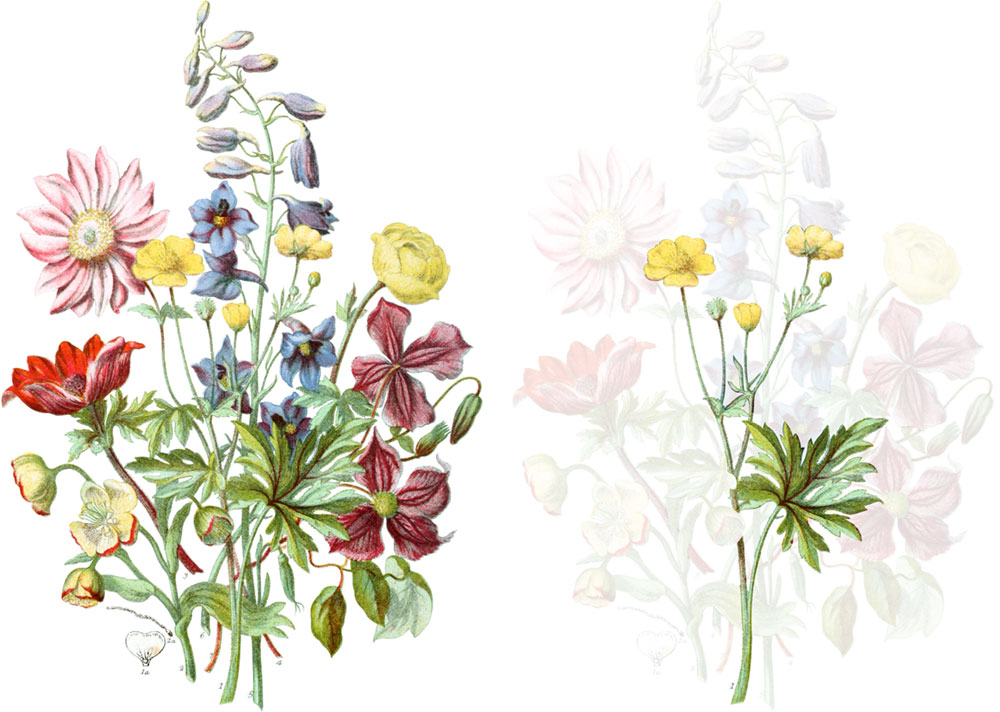
The common buttercup may be considered as a perfect type of that numerous tribe “Ranunculaceæ,” named from the genus, and abounding chiefly in the northern countries of Europe.
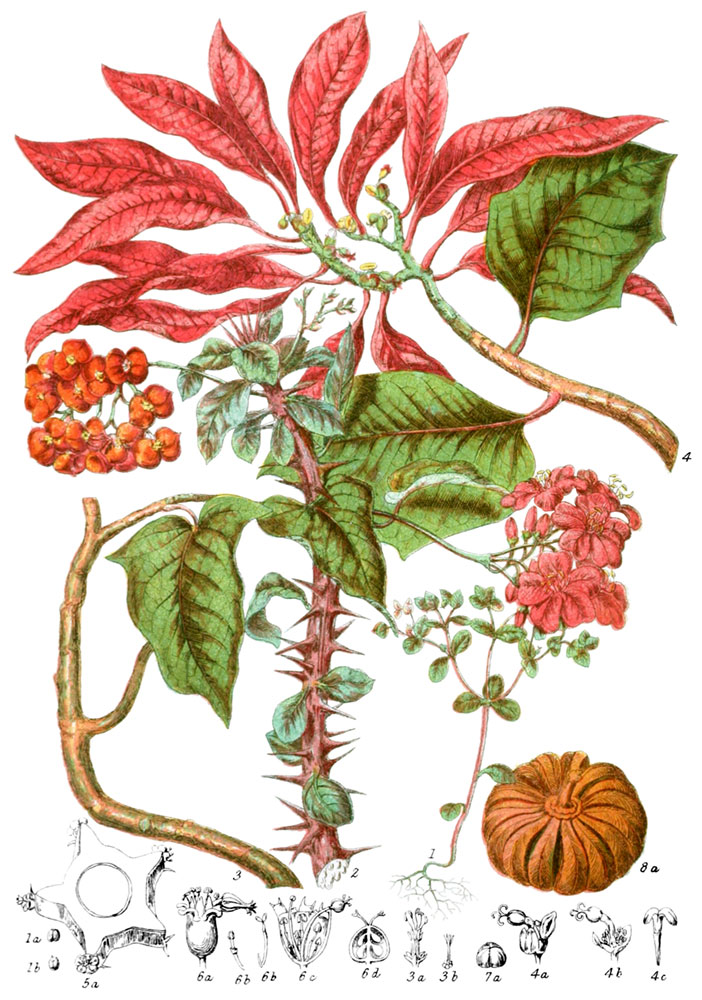
The study of Euphorbiaceæ, the Spurge tribe, in this country, will show either small herbaceous weeds in gardens, or a few other species, of rather large size, but not more pleasing aspect, in woods and hedges; but, on examination, one chief character of the Order will be observed, namely, an abundant milky juice of extreme acridity. The very curious arrangement of the parts of the flower may be perceived, also, as well in these as in the larger species which grow in tropical America, or on the mountains of Northern India, or at the base of the Peak of Teneriffe; some of which attain a gigantic size, rising in upright, angular columns, or with variously branched stems, beset with strong spines. These have, indeed, a very different aspect from that of our small weeds of this tribe, but the essential characters are the same.
Among those tribes of which we have the finest specimens in the British isles may be noticed the oak, elm, ash, and willow-trees: these all attain a vigorous growth in the temperate climate of this country. The oaks of England are not surpassed in any other part of the world. The ash of the Isle of Wight rivals that of North America. Of some tribes we possess only a few species, which are beyond the boundaries of the chief mass of the group,—as in the Mallow tribe, which belongs principally to the tropics, extending a few small species into our temperate region. In other tribes, we have one genus in Britain, a few more in France or Germany, and discover the main centre of the group in some other part of the continent. This occurs in Cistaceæ; Helianthemum is the only British example. Cistus is found in Germany and Switzerland, and the chief mass of the tribe is in Spain and Portugal. There are many tribes of which we possess only small herbs, but when we follow them out into hotter countries we often perceive shrubs or large trees belonging to the tribe. Perhaps the same genus may be expanded into shrubby species in warmer regions. The English species of flax are all small herbs; in the East Indies one is an evergreen shrub. Of the Umbelliferous tribe, we have numerous herbs only; Bupleurum fruticosum is an evergreen shrub, five or six feet high; Bupleurum canenscens on the coast of Barbary is an hoary evergreen of still larger growth.
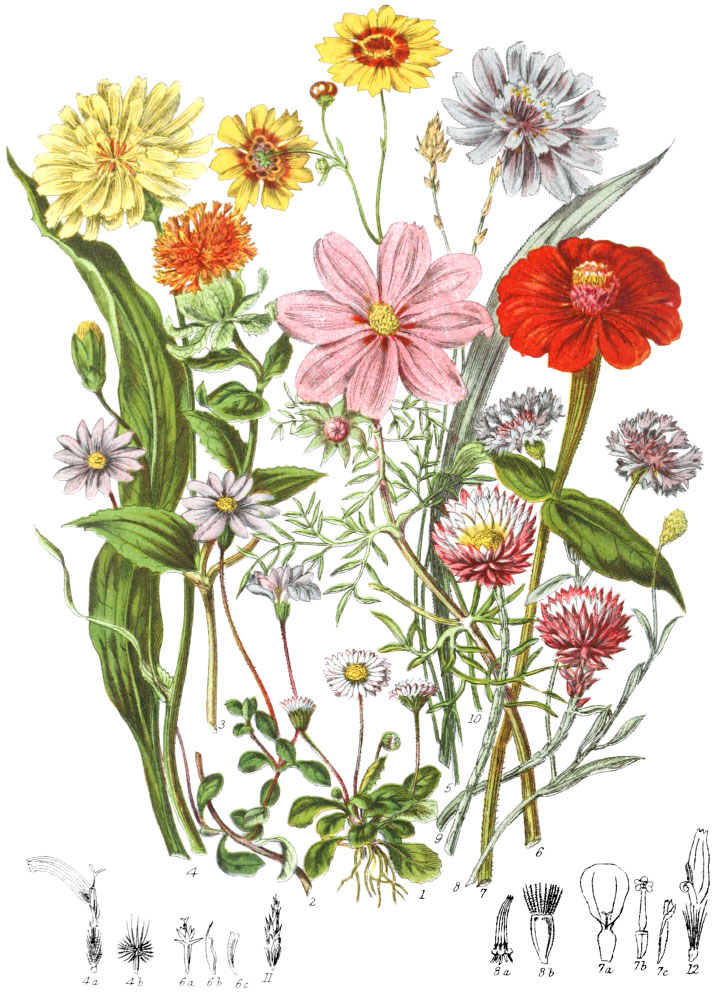
Of the extensive tribe of composite plants forty-five genera are found in Britain, many of them vary plentifully, as the Daisy, Thistle and others; but all herbaceous, and nearly all of low growth. The great Scotch Thistle, one of the finest of the tribe, is seldom more than five or six feet in height. Some, however, of the British genera may be found existing in other countries, and there developed in very different specific forms, as shrubs or trees. Sonchus, of very tender, succulent nature here, affording food for rabbits,is known in Madeira and in the Canaries in the form of evergreen shrubs. Some of the largest trees of St. Helena belong to this composite tribe.
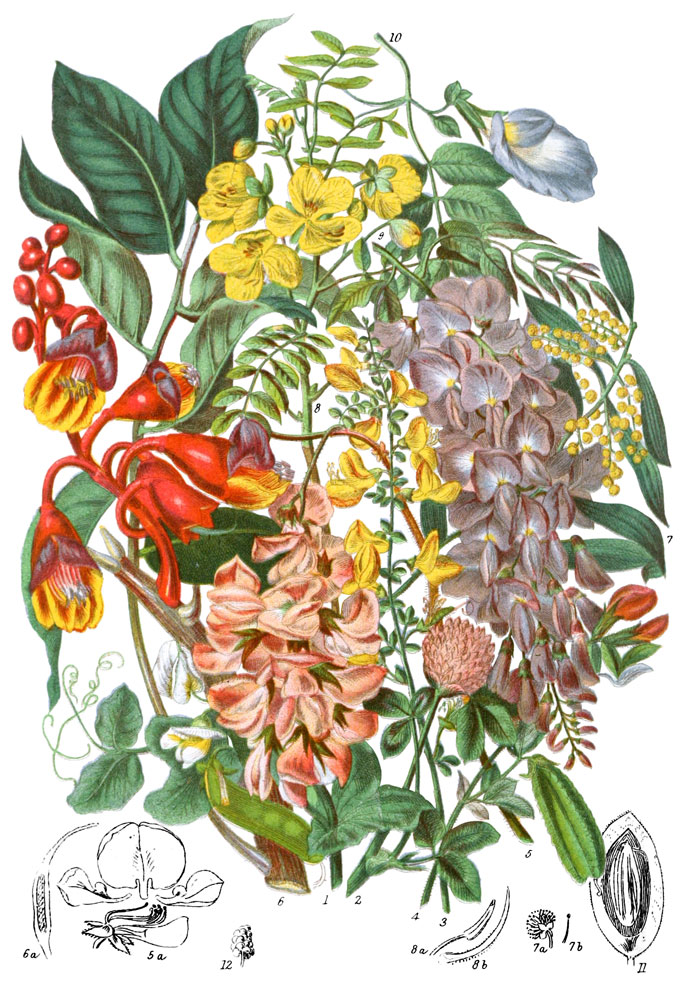
Among the various native species we have the vast Leguminous tribe, only Ulex, the Furze, and Spartium, the Broom, are of a shrubby nature. Proceeding towards the south of france, we meet with the Laburnum, and other trees of considerable size. Advancing still further into tropical regions, this important tribe is found in shrubs and lofty trees, of varied utility and beauty. Amherstia nobilis, of the East Indies, is a large tree bearing magnificent drooping branches of scarlet flowers, said to be unsurpassed in the vegetable world. The Hymenea of Brazil has been found to measure eighty-five feet around the base of the stem; it is said to live to 2000 years.
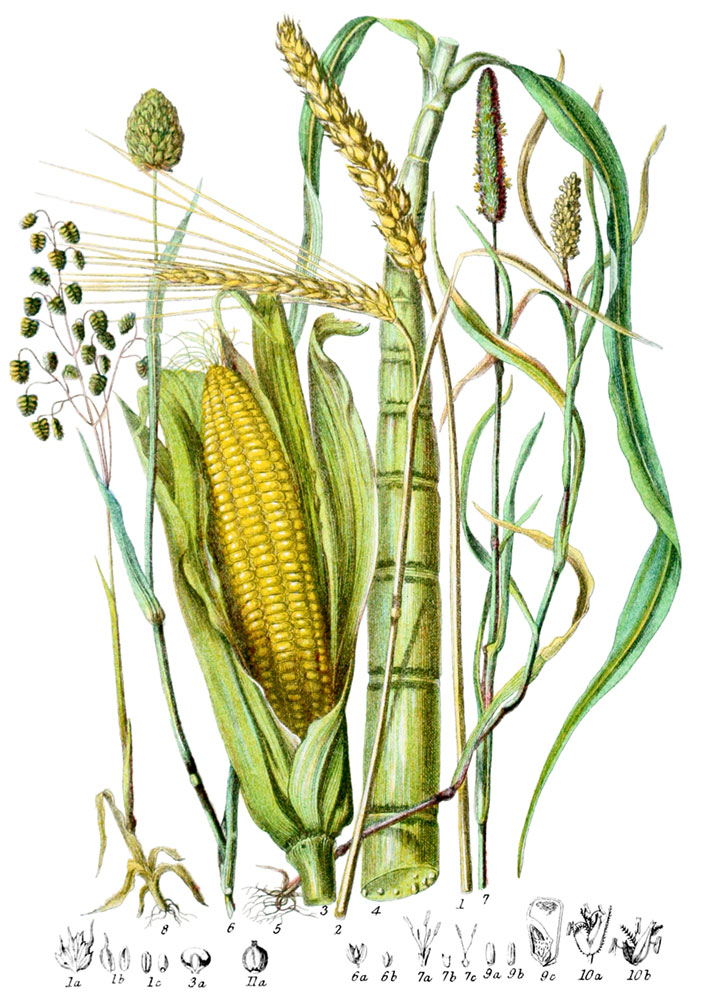
Of the grass tribe, we have lowly specimens only: our native species incline more to the northern than the southern types. Poa, our meadow grass, stretches to the icy regions of Spitzbergen and Melville Island. Other of our grasses are found also to the south; and these frequently in lofty situations, as on the alps, near the limits of perpetual snow; on the Andies, and on the Himalayas. Arundo Phragmites, is the common reed, our largest species of this tribe; in the deep ditches about the mouth of Thames, it gives an idea of the more gigantic grasses of the South. Arundo Donax, of North Africa, advances into the South of Europe, and gives a clear indication of the more highly developed tropical species. But there is one striking character of this tribe which we perceive as distinctly in this country as anywhere: the peculiar property of spreading over wide spaces of ground with scarcely any intermixture of other plants, can nowhere be better observed than in our meadows and lawns. In the Tropics, large grasses grow separately, like other plants, are of greater size and height, and in some instances have wider leaves than any of the species belonging to the temperate zone, and assume partly in the appearance of trees.
In examining other tribes, we find the same genera or species widely spread in distant countries, and retaining the same form and appearance, but growing in different situations, where there may be a climate favourable for their growth. Vaccinium Myrtillus, the Bilberry, is a low shrubby plant, spreading over a wild ground; it abounds in various parts of Britain, either on heaths, or on rocks of no great elevation, as those of Tunbridge Wells; or on a turfy soil in the northern counties of England, and the moors of the Scotch Highlands. In Switzerland it is not confined to low rocks or moors; it is also to be found on the turfy heights of the Alps; on the higher part of the Simplon Pass it covers the ground on all sides, and in autumn gives a bright colouring to the scene by its red leaves.
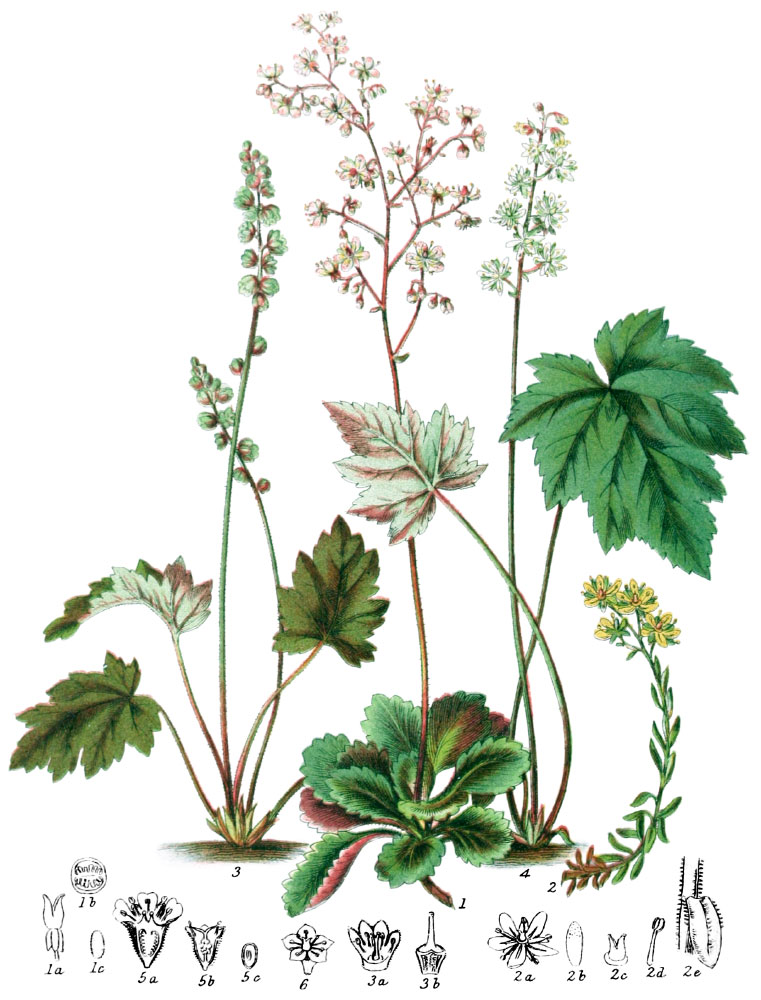
In the Saxifrage tribe, there is very little diversity of form or situation. It is extensively scattered over all Northern countries, merely varied in position according to the climate. For example: Saxifraga oppositifolia, which is abundant on the highest hills of Wales, Yorkshire, or Scotland, is found also in Switzerland, Germany, and France; but in those countries, in still loftier localities than those of Britain. It may be seen on the nothern slopes of teh Pyrenees, on the mountains of Moravia and Bohemai, and on the Grimsel, Ghemmi, Righi, St. Gothard, and other Alps, at an elevation sometimes approaching the limit of perpetual snow. This little plant is also to be traced as far north as Melville Island in 75° of N. lat. There it finds a sufficiently cold temperature on the level plain, the dreary monotonoy of which it enlivens with its bright purple flowers, on the earliest arrival of spring. The budding of this small Saxifrage was one of the welcome indications of spring that gladdened the hearts of Captain Parry and his crew, after their ice-bound winter in the Polar regions.

The Juniper of our northern moors is another plant that is widely dispersed, and consequently inhabits very dissimilar localities. If we follow it northwards, we shall find its low stunted form on the level plains of Lapland, which are during a great portion of the year covered with snow. If we search for it in hot countries, it will be found only on mountains, as on the western slope of the Himalayas, at 14,500 feet.
There are, however, a few minute plants among the lower tribes, which are not only entirely of the herbaceous class, but which, in whatever part of the world we discover them, inhabit similar situations, floating always in still waters. Callitriche verna, the Water Star-wort, so plentiful in the ditches and ponds of England, has also been observed in Lord Auckland’s Isle, in 65° of S. lat., and in the Azores, in 38° of N. lat. In Iceland, in 65° of N. lat., our Callitriche autumnalis covers the ponds and ditches. In these humble plants, we not unfrequently find a greater power of adaption to various climates and stations, and a more extensive dispersion over the globe, than the higher tribes. It is remarkable what varied forms of vegetation assumes, and in what strange situations it is found.

Deep in the coal-mines of Saxony, far from the light of day, grows Rhizomorpha subterranea, a small branching plant, on the limits of the Fungus tribe, which possesses phosphorescent properties, and shines in the dark with great brilliancy. Racodium cellare is a very singular substance of the Fungus kind, that occasionally grows in cellars, filling every space with its hanging masses of black fibres. Rocks which appear at a distance to be bare, are often perceived on closer examination to be clothed with a thin covering of flat Lichens, of various kinds, some of which adhere so firmly as to be inseparable from it. Some of the Confervæ have been found growing in boiling springs in Arabia, at the Cape of Good Hope, and in the Geysers of Iceland. Marchantia and Lycopodium were seen close to hot springs in the Island of Amsterdam, in the Indian Ocean. Several of these lowest tribes of plants are also capable of enduring extreme cold. The Reindeer Lichen covers extensive plains in Lapland, where it is buried under thick snows for many months without injury. Protococcus nivalis, a minute plant on the verge of vegetable life, was first noticed by Saussure, on the perpetual snows of the Alps, tinging the surface with a red hue: it consists of simple cells filled with a red fluid, and has obtained the name of Red Snow, from its appearance to Captain Ross and his crew during their expedition to the Polar regions, where it was discovered reddening vast plains of snow and ice.
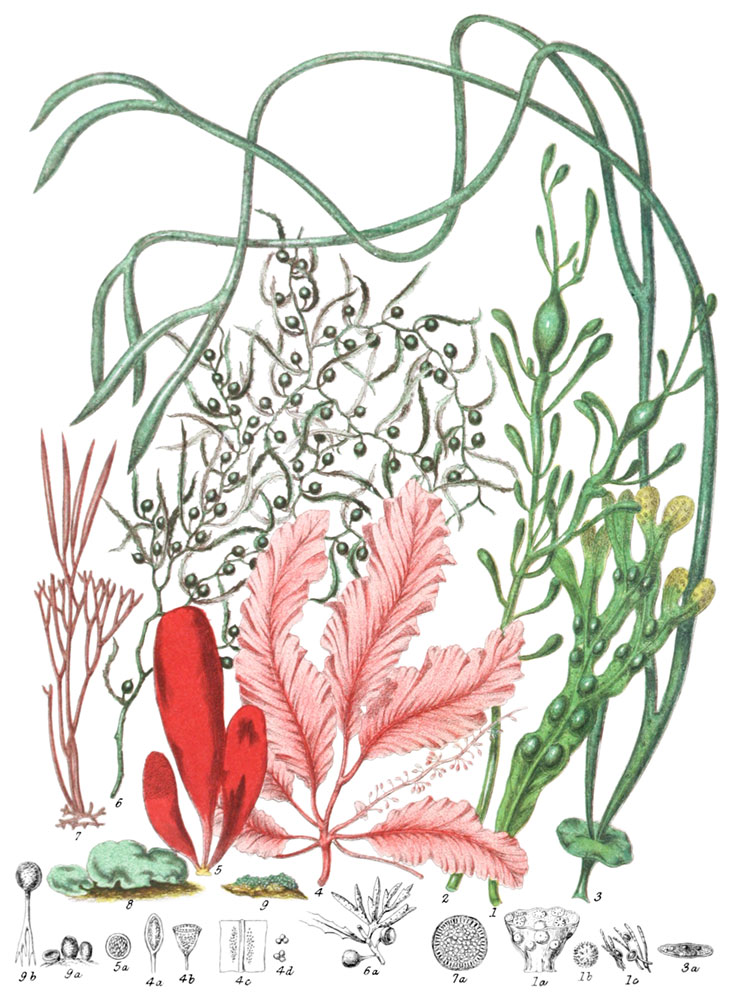
Various kinds of Algæ, or Sea-weeds, pervade both salt and fresh water in every possible situation. Some are so exceedingly minute as to be scarcely perceptible to the naked eye; others far exceed in length of stem any land plant. Mycrocystis pyrifera is a tropical genus, inhabiting the Indian Ocean: the slender stems are said to reach the enormous length of 1500 feet. The sargassum, or Gulf-weed, which Columbus met with; like a floating meadow on the Atlantic Ocean, is often seen in large masses, extending from 25° to 36° N. lat. Some species flourish in shallow water, others in deep sees. Fucus vitifolius was brought up from a depth of 190 feet, off the Coast of the Canaries, by Humboldt and Bonpland, and exhibited the peculiar property which sea-weeds possess of acquiring green colour without the aid of light.
Truly “the earth is full of riches; so is the great and wide sea also!” Not only does the land bring forth abundantly every green herb and tree after its kind, but the waters are also full of suitable vegetation affording food and shelter to the “things creeping innumerable” that dwell therein. It is remarkable that among those plants considered useless, are to be found the most striking examples of beautiful form, brilliant colour, and fragrant scent, as is particularly in the case of the Lily and the Orchis tribes, as if thus to remind us that they also are not to be disregarded; that they are to be observed for some good and wise purpose; that we may admire them for their excellent beauty, and examine their wonderful structure, and perceive, thus more clearly, the omnipotence and the mercy of the creator, who knoweth whereof we are made, who seeth that our path is beset with many thorns, and that our spirits, as well as our bodies, are liable to weariness, and need refreshment and cheering as we pass on our pilgrimage.
Even the so-called useless plants may have their allotted service to man; and though not offering any material uses, may be made available for other and higher purposes. They can perform a share of the great work of enlightening the mind, and refining the taste, and purifying the heart for true and simple enjoyment. They are no invention of fallible man, who, even in hits best plans for gratification or recreation, often fails of the intended end; they are the gifts of our heavenly Father, accessible to all His children. The joyous can go gladly forth on their sunny path in the bright garden; the weariest can weakest may rest on their way on the green herb and lowly flowers; and the busiest even in the crowded city may derive cheering delight from the humble window-garden, and will readily pause on their course to “consider the lilies how they grow.”
Posters
Decorate your walls with colorful detailed posters based on Elizabeth Twining’s beautiful two-volume set from 1868.
Puzzles
Challenge yourself or someone else to assemble a puzzle of all 160 botanical illustrations.